Introduction: Overgrown trees can be a beautiful addition to your landscape, providing shade and a sense of natural beauty. However, when trees become excessively dense or out of control, they can pose safety risks and hinder their overall health. Pruning is a solution to restore balance and vitality to overgrown trees. In this blog post, presented by Lakenheath Tree Surgeons, we will discuss the essential steps and techniques for safely and effectively pruning overgrown trees.
Step 1: Assess the Situation
Before you start pruning, assessing the tree’s condition and identifying specific problem areas is crucial. Determine whether the tree is overgrown due to a lack of previous pruning or if it has experienced rapid growth recently. Understanding the tree’s growth patterns will help you plan your pruning strategy effectively.
Step 2: Gather the Right Tools
The right tools for the job are essential for safe and effective pruning. Some common tools you may need include:
- Pruning shears for smaller branches.
- Loppers for thicker branches.
- A pruning saw for large branches.
- Safety equipment, including gloves, safety glasses, and a helmet.
- Ensure all your tools are sharp and in good condition to make clean cuts that promote faster healing.
Step 3: Prioritise Safety
Safety should be your top priority when pruning overgrown trees. Here are some safety tips to keep in mind:
- Wear appropriate safety gear, including gloves, safety glasses, and a helmet.
- Maintain a safe distance from power lines.
- Be cautious when using ladders or climbing the tree. It’s often best to leave this to professionals.
Step 4: Identify Dead or Diseased Branches
Start by identifying and removing any dead or diseased branches. Deadwood affects the tree’s appearance and poses a risk of falling during strong winds. Pruning these branches will improve the tree’s overall health and safety.
Step 5: Selectively Thin the Canopy
Overgrown trees often have dense canopies that block sunlight and air circulation. Selectively thinning the canopy by removing some inner branches can promote better growth and reduce disease risk. Aim to maintain the tree’s natural shape while removing excess growth.
Step 6: Elevate the Crown
If the tree’s lower branches obstruct walkways or structures, consider elevating the crown. Remove the lower branches carefully, ensuring not to cut too close to the trunk. This will create more clearance while maintaining the tree’s health.
Step 7: Prune for Structure
Pay attention to the tree’s structure and balance. Look for branches that cross each other or have weak attachments. Prune these branches to create a stronger and more stable tree.
Step 8: Gradual Pruning
Pruning overgrown trees is a process that may need to be done gradually over several seasons. Avoid removing more than one-third of the tree’s canopy at once to prevent shock and stress.
Conclusion: Pruning overgrown trees requires careful planning, the right tools, and understanding of the tree’s growth patterns. While you can perform some pruning tasks for larger or more complex trees, consulting with professionals like Lakenheath Tree Surgeons is advisable. Properly pruned trees look better and thrive, adding beauty and value to your landscape while ensuring safety.
Call us on: 01842 771 096
Click here to find out more about Lakenheath Tree Surgeons
Click here to complete our contact form and see how we can help with your tree’s needs.

